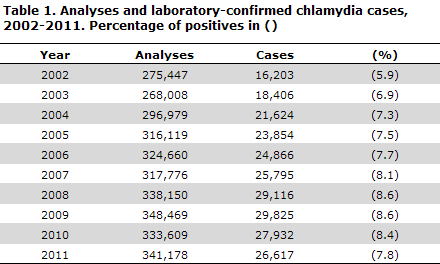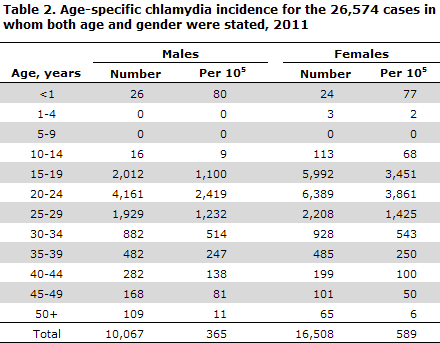No 35 - 2012
Chlamydia 2011
Chlamydia 2011
The laboratory notification system for chlamydia (oculogenital infection caused by Chlamydia trachomatis) receives quarterly data on laboratory-diagnosed chlamydia from clinical microbiology departments and from one clinical biochemical department. In 2011, the number of reported chlamydia cases was 26,617.
This corresponds to an annual incidence of 479 per 105 (505 per 105 in 2010 and 541 per 105 in 2009). A total of 341,178 analyses were performed, and chlamydia was detected in 7.8% of those tested, Table 1.

A total of 80% of the males and 88% of the females were aged 15-29 years (81% and 88%, respectively, in 2010), Table 2.

As in 2010, the highest incidence among males was found among 21-year-olds, Figure 1. Among females, the highest incidence was observed among 19-year-olds as in 2010, but the incidence had decreased to nearly the same level as that of 2004.
For males, the incidences were lower than in 2010 in every one-year group from 15 to 23 years, and among females this was the case for 15-20 year-olds. As in 2009 and 2010, males constituted 38% of the diagnosed cases. This proportion has increased steadily from 23% in 1994.

Geographical distribution
Based on the municipal code of the practice or hospital department performing the sampling, each individual chlamydia case may be ascribed to a specific municipality, part of country or region, Table 3.

Diagnostics
A total of 92% of the positive specimens were submitted by GPs, 7% by hospitals. All cases were detected using DNA amplification methods. Chlamydia was detected in urine samples in 8,834 cases, i.e. 33% of all cases (34% in 2010). Male samples constituted 90% of the positive urine samples (88% in 2010). Urine was used as sample material in 79% of the male chlamydia cases (79% in 2010). All laboratories reported positive findings in urine specimens. Rectal chlamydia was detected in 131 males (127 in 2010).
Chlamydia in children
Chlamydia was found in 183 children less than 15 years of age (257 in 2010 and 299 in 2009). Among these, 51 (28%) were under one year old, all of whom had conjunctivitis. Among 13 children under the age of one year with conjunctivitis, where the age was stated in months, ten were aged less than one month and three were one month old. Urogenital chlamydia was detected in 11 girls aged 13 years, 102 girls aged 14, and also in one 13-year-old and 15 14-year-old boys.
The incidence among 10-14-year-old girls was 68 per 105 in 2011 (99 in 2010 and 127 in 2009), while the corresponding figure for boys was 9 per 105 (14 in 2010 and 11 in 2009).
Commentary
The number of chlamydia analyses was 2% higher in 2011 than in 2010, and the number of detected cases was 5% lower. Both the positive rate and the incidence had decreased. This was a particularly clear trend in 15-20-year-olds of both sexes. Such trend may be associated with a change in risk behaviour thanks to condom campaigns or an increased focus on testing and treatment.
The male proportion of the detected cases remained, as in 2009 and 2010, at 38%, but there is no reason to believe that chlamydia is less prevalent among males than among females. Increased sampling of males must therefore be encouraged.
The number of males who had rectal chlamydia detected remained practically unchanged. When rectal chlamydia is found in a male, he should also be tested for syphilis, gonorrhoea and lymphogranuloma venereum (LGV), EPI-NEWS 20/08.
(S. Hoffmann, Microbiology and Infection Control)
4. september 2012
Link to previous issues of EPI-NEWS